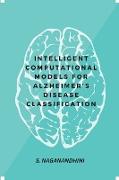- Start
- Intelligent Computational Models for Alzheimer's Disease Classification
Intelligent Computational Models for Alzheimer's Disease Classification
Angebote / Angebote:
Medical image is a type of digital image processing that has widened its
boundaries over the decades. It is a primary source for the visual representation
of a human system's internal organs for clinical interpretation and intervention.
The growth and developments in this field have triggered the development of
novel algorithms for data/ image processing.
The medical imaging modalities are medical imaging and processing,
Structural Magnetic Resonance Imaging (sMRI), Functional Magnetic
Resonance Imaging (fMRI), Digital Mammogram, Ultra Sound (US), Positron
Emission Tomography (PET), Electrocardiogram (ECG), and Computer
Tomography (CT) that have promoted research in many allied fields including
Geographical Information Systems (GIS), Forensic Science, Business Data
Analytics and Astronomy.
Digital Image is mathematically represented as a twodimensional
function, f(x, y) where x and y are the spatial coordinates, and the
amplitude f at any given pair of coordinates (x, y) is called intensity. Digital
Image Processing (DIP) is the subject area that deals with processing/
manipulating a digital image by a digital computer to obtain useful and necessary
information from it. The different elements of a DIP system include image
acquisition, image storage, and image processing.
Medical image processing is an offshoot of DIP, which involves using
technology to process the human body's medical images. Medical imaging is also
referred to as diagnostic imaging. Medical imaging aims to visualize the human
body's inner parts, which is required to identify internal abnormalities such as
broken bones, tumors, and leaking blood vessels. In medical imaging,
segmentation aims to study anatomical structure, demarcate and distinguish a
region and help in therapeutic planning and treatment.
Recent medical image diagnosis encompasses the advancement of the
latest technology for acquiring the medical images by different modalities used
for diagnosis, treatment, and research. Medical image processing covers a broad
array of operations categorized as low-level, mid-level, and high-level image
processing based on computation complexity. Medical image segmentation
contributes to analyzing human anatomy and diagnosing the disorders, using
automated or semi-automated computational systems. The foremost objective of
medical image segmentation is to extract the regions to study the intrinsic
anatomical structure and estimate the severity of abnormalities that help in
deciding the means and methods of treatment. These aspects motivate
researchers to develop competent computing techniques for pre-processing,
segmentation, and analysis. These techniques' novelty is commonly ascertained
by three metrics, namely, precision, recall, and F1-Score.
Folgt in ca. 5 Arbeitstagen
